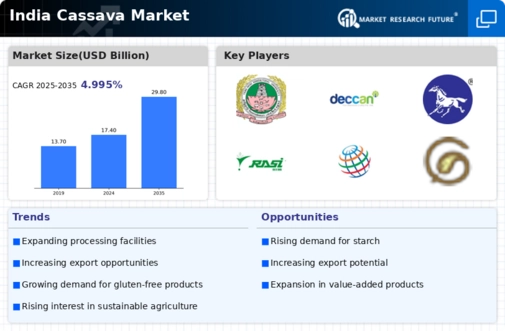Rising Export Opportunities
India's cassava market is witnessing a notable increase in export opportunities, driven by the global demand for cassava products. Countries in Europe and Asia are increasingly importing cassava for its versatility in food and industrial applications. Recent data suggests that India's cassava exports have grown by around 25% over the past year, indicating a robust international market. This trend is likely to encourage local farmers and producers to enhance their production capabilities, thereby contributing to the overall growth of the cassava market. The potential for increased revenue from exports may further stimulate investment in processing facilities and infrastructure.
Increasing Health Consciousness
The growing awareness of health and nutrition among consumers in India appears to be a significant driver for the cassava market. As individuals seek healthier food options, cassava, known for its gluten-free properties and high carbohydrate content, is gaining traction. The market data indicates that the demand for gluten-free products has surged by approximately 30% in recent years. This trend is likely to continue, as more consumers are inclined to incorporate cassava-based products into their diets. The cassava market is thus positioned to benefit from this shift towards healthier eating habits, potentially leading to increased sales and product innovation.
Supportive Agricultural Policies
The Indian government's supportive agricultural policies are playing a pivotal role in the growth of the cassava market. Initiatives aimed at promoting sustainable farming practices and providing financial assistance to farmers are likely to enhance cassava cultivation. Recent reports indicate that government subsidies for cassava production have increased by 15%, encouraging more farmers to engage in its cultivation. This support not only boosts local production but also strengthens the cassava market by ensuring a steady supply of raw materials for processing and distribution. The potential for improved yields and profitability may further attract investment in this sector.
Diverse Applications in Food Industry
The versatility of cassava in various culinary applications is a crucial driver for the cassava market in India. From traditional dishes to modern food innovations, cassava is being utilized in a range of products, including snacks, flour, and beverages. The market data reveals that the demand for cassava flour has increased by approximately 20% in the last year, reflecting its growing acceptance among consumers. This trend suggests that the cassava market is likely to expand as food manufacturers explore new ways to incorporate cassava into their offerings, catering to diverse consumer preferences and dietary needs.
Technological Innovations in Cultivation
Technological advancements in agricultural practices are emerging as a key driver for the cassava market in India. Innovations such as precision farming and improved seed varieties are likely to enhance productivity and reduce cultivation costs. Recent studies suggest that the adoption of these technologies could increase cassava yields by up to 40%. This potential for higher output may encourage more farmers to invest in cassava cultivation, thereby strengthening the cassava market. As productivity improves, the overall supply chain may also benefit, leading to more efficient processing and distribution of cassava products.


















Leave a Comment